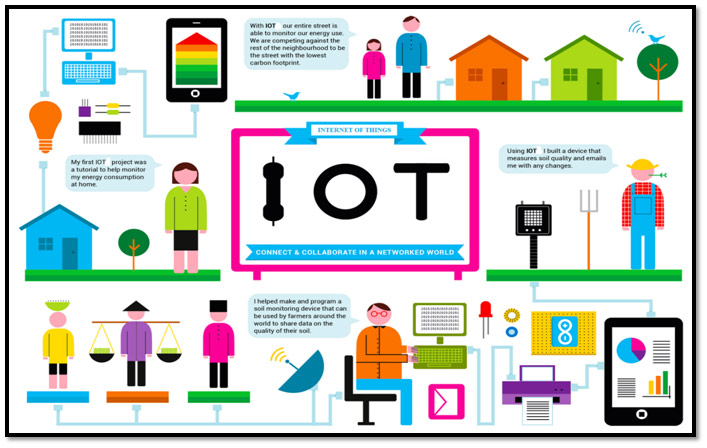Internet of Things (IoT): Technology for a smart environment

-Mr. Shailesh Saxena
When people talk about “the next big thing” they are never thinking big enough. It’s not a lack of imagination; it’s a lack of observation. I have maintained that the future is always within sight, and you don’t need to imagine what is already there. Smart devices, smart phones,smart cars,smart homes,smart cities, anda smart world…..these notions have been espoused for many years. Achieving these goals has been investigated by many diverse and often disjointed research areas. Five such prominent research areas are: Internet of Things (IoT), Mobile Computing (MC), Pervasive Computing (PC), Wireless Sensor Networks (WSN), and most recently, Cyber Physical Systems (CPS).
Many people, including myself, hold the view that cities and the world itself will be overlaid with sensing and actuation, many embedded in “things” creating what is referred to as a smart world. However, it is important to note that one key issue is the degree of the density of sensing and actuation coverage. I believe that there will be an inflection point when the degree of coverage triples or quadruples from what we have today. At that time there will be a qualitative change. For example, today many buildings already have sensors for attempting to save energy; home automation is occurring; cars, taxis, and traffic lights have devices to try and improve safety and transportation; people have smartphones with sensors for running many useful apps; industrial plants are connecting to the Internet; and healthcare services are relying on increased home sensing to support remote medicine and wellness.
However, all of these are just the tip of the iceberg. They are all still at early stages of development. The steady increasing density of sensing and the sophistication of the associated processing will make for a significant qualitative change in how we work and live. We will truly have systems-of-systems that synergistically interact to form totally new and unpredictable services.
What will be the platform or platforms that support such a vision? One possibility is a global sensing and actuation utility connected to the Internet. Electricity and Water are two utilities that can be used for myriad purposes. Sensing and actuation in the form of an IoT platform will become a utility. IoT will not be seen as individual systems, but as a critical, integrated infrastructure upon which many applications and services can run. Some applications will be personalized such as digitizing daily life activities, others will be city-wide such as efficient, delay-free transportation, and others will be worldwide such as global delivery systems. Smart buildings will not only control energy or security, but integrate personal comfort, energy savings, security and health and wellness aspects into convenient and effective spaces. Individuals may have patches of bionic skin with readings of physiological parameters being transmitted to the cloud which houses their digital health. In fact, smart watches, phones, body nodes, and clothes will act as personalized input to optimize city-wide services benefiting both the individual and society. Consequently, we will often (perhaps 24/7) be implicitly linked into the new utility. Some examples of new services include immediate and continuous access to the right information for the task at hand, be it, traveling to work or a meeting, exercising, shopping, socializing, or visiting a doctor. Sometimes these activities will be virtual activities, or even include the use of avatars or robots. Many outputs and displays for users may be holographic. Credit cards would disappear and biometrics like voice or retinas will provide safe access to buildings, ATMs, and transportation systems.
A sensing and actuation utility will not only exist in public spaces, but also extend into the home, apartments, and condominiums. Here people will be able to run health, energy, security, and entertainment apps on the infrastructure. Installing and running new apps will be as easy as plugging in a new toaster into the electric utility. One app may help monitor and control heart rate, another could perform financial and investments services, yet another automatically orders food and wine, or even predicts an impending medical problem that needs to be addressed early. Humans will often be integral parts of the IoT system. Consequently, in the future the scope of IoT is enormous and will affect every aspect of all our lives.

Mr Shailesh Saxena is Head of Department, Computer Science & Engineering, at SRMS CET&R

